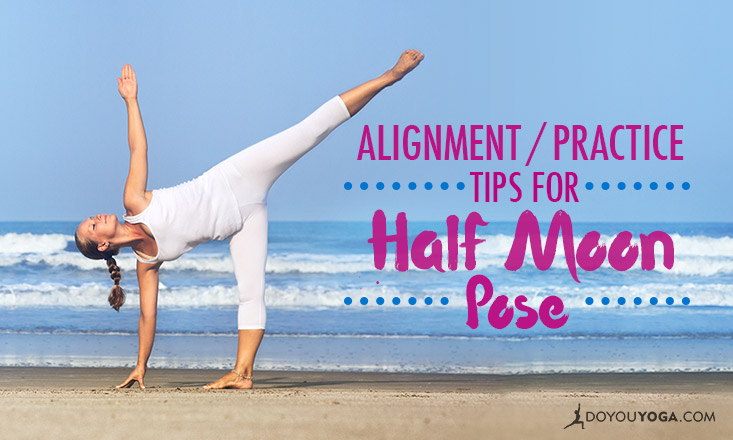Half Moon pose is fun, daunting, challenging and makes you feel amazingly accomplished after balancing here for a while. It strengthens your feet, ankles and legs, in addition to your core.
Some teachers will usually have students start in Triangle pose and then lift the back leg to come into balancing Half Moon pose. In my classes, I like to cue a balancing Five Pointed Star into a balancing Half Moon pose. I’ve also used it as part of a super challenging standing flow sequence.
If you're practicing this pose by yourself at home, use the following tips and tricks to enjoy this pose and progress in your practice.
1. Open the chest and shine your heart to the side of the room.
If you find your top shoulder or chest facing more toward the floor, this is an indication you are still working on more balance and core strength. As a great prop option, use a wall to find that opening and balance you look for.
2. Use a block to find extra length for the bottom arm.
Often, students can reach to the floor for support and pull themselves out of alignment in their opening chest. Prop the block up on the highest height that helps.
3. Push through the heel of the upper leg (dorsiflexion of the foot) to engage the upper leg muscles.
These engaged quadriceps muscles, hamstrings muscles, and calf muscles will help you to leverage and balance to find that sideways position. Engaging these leg muscles will also help to keep the pelvis in proper alignment.
4. Modify your arm placement.
The arm is usually cued reaching perpendicularly toward the sky, but if that does not serve you, then feel free to prop the arm on the waist. Bend the top arm at the elbow and place the hand on the hip. This simpler arm position option can sometimes be just the thing you need to feel balanced. Additionally, this adjustment is great for students with tight or injured rotator cuff muscles of the shoulder.
5. Be mindful of neck safety and comfort.
Balancing Half Moon pose is great for lengthening the spine and that includes the cervical spine (your neck). Keep your neck safe. Look to the upper hand, look forward, or look down. Keep yourself comfortable.
Looking forward or upward will help to keep the chest opened, while looking down may pull the top shoulder toward the floor. If looking upward blurs your vision or makes you lose your balance, then find the neck position that serves your pose in the best way.
Remember that if you are not completely balanced yet, you will be some day. Remember that if you are not completely turned to the side, you will be one day. Remember to have fun with your yoga practice. Remember that practice makes progress.


